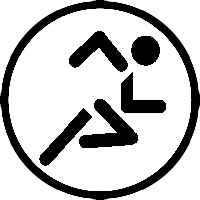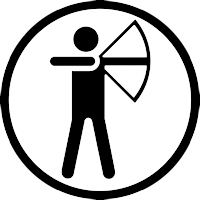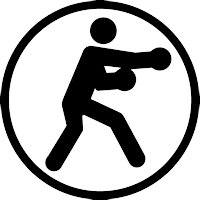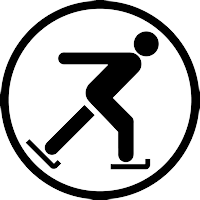Compound bows shoot arrows at over 300 fps (feet per second), compared to recurves which do closer to 200 fps - which gives an archer a significant advantage when it comes to shooting longer distances.
Take for example the following bow: "The 2017 Mathews Halon 32". (I am not endorsing this bow, I am just using it as an example of a fast compound bow.)
The Mathews Halon 32 has a top IBO speed of 350 fps.
The Halon 32 is not alone in this category of high speed compound bows. Here is a brief list of manufacturers (all 2017 models currently available on the market) and their top IBO speeds:
- APA Mamba M34TF - 355 fps
- Bear Legend LS6 - 355 fps
- Xpedition Xplorer SS - 355 fps
- Bowtech Reign - 350 fps
- Hoyt Pro Defiant - 350 fps
- Darton Maverick II - 350 fps
- Obsession Turmoil - 350 fps
- PSE Evolve - 346 fps
- Bear Moment - 340 fps
- Hoyt Double XL - 340 fps
- Obsession Hemorrhage DE - 340 fps
- PSE Bow Madness Epix - 340 fps
- PSE Carbon Air 34 ECS - 336 fps
- Prime Centergy - 333 fps
- Hoyt Carbon Defiant - 331 fps
- Bear Legend LS4 - 330 fps
- Cabela's Fortitude - 330 fps
- Martin Firecat - 330 fps
- Prime One STXv2 - 325 fps
- Bowtech Fanatic 3.0 - 320 fps
- Mathews Avail - 320 fps
- Mathews Stoke - 314 (youth bow)
- Gearhead T15 Pro - 237 (micro hobby bow)
So immediately what you learn here is that even the smallest compound bows, like the Mathews Stoke youth bow and Gearhead micro bow, still shoot arrows at faster speeds than recurves. Compound Bows (and those people who are big fans of them) are essentially speed freaks.
You also learn that 300 fps is really more of a minimum. As you can see most of the normal adult compound bows are shooting between 320 to 350 fps.
So why does speed matter for shooting longer distances?
The short answer: Longer arcs equals more accuracy.
Arrows arc their way upwards and eventually downwards at longer distances. At short distances arrows arc up (which means the archer has to aim the arrow significantly below the target), at medium distances they begin to arc downwards (which means the archer has to start aiming higher, possibly just below or just above the target - depending on the distance), and at long distances arrows arc dramatically lower.
If the arc is really short (shot from a weak or possibly sluggish bow), the shots lose accuracy because of the slightest change in aim. In comparison a strong / fast bow will shoot arrows with a flatter trajectory, which allows an archer to more easily make aim corrections that rapidly increase their accuracy. They don't have to worry about the arc of the arrow so much, whereas someone shooting a weak / sluggish bow does.
Remember: The faster the arrow is going, the longer the arc is, the more accurate the arrow will be at longer distances due to the archer being able to more easily adjust their aim.
Is there any reasons why you would not want more speed?
Well, there are some pros and cons - depending on what you are shooting for.
The speed of the arrow is directly tied to the amount of kinetic energy being released from the bow (via the bowstring) and into the arrow, propelling it forward at incredible speed.
- The heavier the arrow, the more kinetic energy it can initially store - and the more momentum and power it retains when it finally hits the target. This makes heavier arrows better for hunting purposes.
- Lighter arrows, although they store less energy, go faster because they weigh less - but at the expense of hitting a target with less kinetic momentum. This makes lighter arrows better for competitive because they want more speed for the purposes of long distance accuracy.
Why would someone choose to use a recurve bow instead of a compound bow?
I shall answer this with a question:
Why would someone choose to use a bow instead of a rifle?
Obviously they have their reasons. Each person might have a slightly different reason.
Thus it really comes down to Personal Preference. People can still get pretty impressive accuracy with a traditional bow - even at long distances.
- Some people find compound bows to be boring.
- Some people find compound bows to be ugly.
- Some people like the challenge of shooting something more traditional.
- Some people like the tradition and history of shooting recurve bows, longbows, horsebows, etc.
- Some people find wooden bows are more visually appealing.
- Some people like making their own bows and thus shooting a "self-bow".
- Some people are drawn to a particular style of archery, such as horseback archery.
Do arrows slow down significantly before they hit a target?
Not by much. It is a common myth that arrows slow down significantly while flying through the air and before hitting the target. Such myths are due to a common misunderstanding about the physics of speed, air resistance, wind, and gravity.
Air resistance and wind has comparatively little effect on the arrow. The big thing is gravity, and that only pulls the arrow downwards. It does not stop forward momentum.
Also an arrow doesn't come to a full stop until AFTER it hits a target. Until it does so, it is still going at a significant speed.
While an arrow is arcing up it still has plenty of forward momentum. That momentum is effectively separate from the power of gravity pulling it downwards. If there was nothing in the way (targets, ground, etc) it would just keep going forward until it lost all of its forward momentum.
There is really only one exception to this:
If you shot an arrow almost straight up it would eventually slow down its vertical climb due to gravity and then start falling - and then pick up speed due to gravity. Thus it did eventually slow down to a speed of almost zero at the top of its zenith, it is always still in motion because it immediately begins its downward ascent and picking up speed again. In theory an arrow could go up, reach its zenith, and then come back down and hit the ground at a speed that was greater than what it was originally shot at - this is because gravity would cause the arrow to accelerate on its downward ascent.
Think of an army of bowmen shooting arrows at an enemy on a distant hill. They aim at the sky, and shoot all their arrows at once in a single volley. The arrows go up, reach their zenith and come back down. They still lots of forward momentum - and they could actually end up going faster due to gravity causing the arrows to accelerate during the downwards arc. Thus when they hit the enemy those arrows are still flying at very impressive and deadly speeds.
And just to able to reach that distance the arrows need to be traveling at a good speed to begin with, which implies that they should be shot from fast / powerful bows.
At the Toronto Archery Range we have a variety of targets people can shoot at ranging from approx. 20 yards to 75 yards (60 feet to 225 feet respectively).
- An arrow shot at a speed of 200 fps reaches the 20 yard target in a mere 0.3 of a second.
- An arrow shot at a speed of 200 fps reaches the 75 yard target in 1.125 seconds.
In theory arrows lose a bit of its speed before they reach 20 yards, and a bit more before reaching 75 yard target, but the distance is still for both is still so short that it is barely worth mentioning. Even at 75 yards, the arrow is probably still doing at least 190 fps at the moment it hits.
For comparison purposes:
- A compound bow shooting an arrow at a speed of 350 fps reaches the 20 yard target in 0.1714 of a second.
- A compound bow shooting an arrow at a speed of 350 fps reaches the 75 yard target in 0.6429 of a second.
And again, the arrows do technically slow down a bit by the time they reach those distances - but the difference is negligible. Guaranteed the arrow is still doing at least 345 fps by the time it reaches 75 yards.
At extreme distances (250 meters or more) you might start notice a larger decline in arrow speed, but the forward arc will still continue until it hits something that gets in its path. A high speed arrow would have to be shot extremely far away (with no obstacles in its way) for it to completely run out of its forward momentum.
How does Newton's Three Laws of Motions apply to Archery?
Newton's First Law of Motion: An object remains at rest/at a constant velocity unless it experiences an unbalanced force.
You may have heard this one before. An object in motion (in this case an arrow) remains in motion until acted upon by an equal or greater force. Thus the arrow keeps its forward motion until it hits an object capable of halting its forward momentum. Air resistance really accounts for a tiny fraction of slowing down an arrow's speed.
When a person pulls back a bow they are storing kinetic energy in the limbs of the bow. When they release the bow, some of that kinetic energy is transferred via the bowstring into the arrow, which propels it forward. Once the arrow is in the air, it meets resistance from air resistance, its trajectory can be modified by wind conditions, and gravity will pull it downwards. However the arrow doesn't stop until it meets resistance sufficient to stop it completely - such as puncturing a target. (eg. See the arrows below sticking out the back of a target.)
Newton's Second Law of Motion: F=ma. Force (measured in Newtons) equals the mass multiplied by acceleration.
The archer applies force when pulling back the bow. That energy is then released as the bowstring goes forward,
which accelerates forward past its original brace height. The arrow doesn't leave the bowstring until the bowstring rebounds back to its normal brace height. Once it leaves the bow, the arrows ceases acceleration and has a speed - which remains at a constant until acted upon by Newton's First Law of Motion.
The bigger the arrow (in terms of weight/mass) the larger the force it stores during the initial release. Heavier arrows hit harder. Lighter arrows go faster because they were able to accelerate faster during the initial release of the bowstring, but consequently also store less energy.
Newton's Third Law of Motion: For every action force, there's an opposite and equal reaction force.
When the bowstring is pulled back that is the action, the reaction is the arrow springing forward from spring force of the bow limbs. Some of the energy released also goes into the bow's limbs and causes vibrations - which can effect the accuracy of the shot. This is why some archers shoot to use things like dampeners (which also reduce the sound of the bowstring), limb savers (which reduce vibration in the limbs), and stabilizers (which reduces vibration in the riser, while simultaneously making the bow bottom heavy so it is less likely to be canted left or right by the archer).
Want to learn more about archery?
Sign up for
archery lessons in Toronto with Cardio Trek.


















































